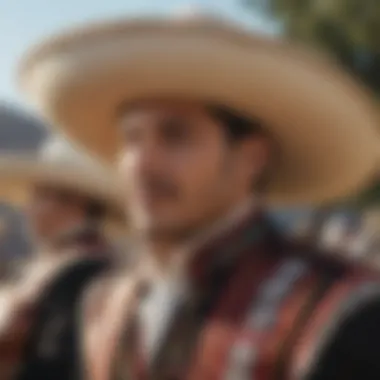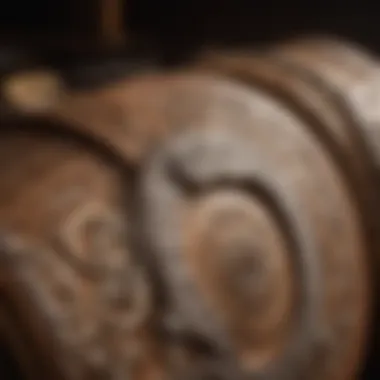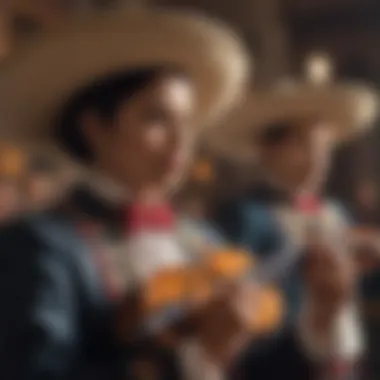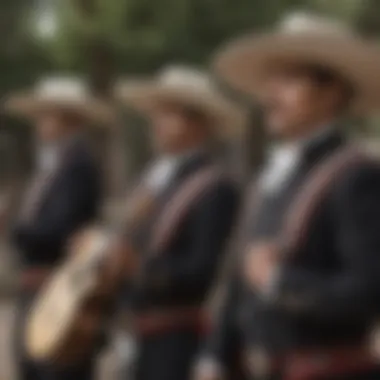Exploring the Cultural Impact of Mariachis in Jalisco


Intro
Mariachi music is often thought of as the heartbeat of Mexican culture, and nowhere is this more palpable than in Jalisco, the birthplace of mariachis. This genre, characterized by its vibrant melodies and spirited rhythms, carries not just notes but stories, rich traditions, and a sense of identity. The history of mariachis is as colorful as their attire, embodying the fusion of indigenous and European influences that shaped much of Mexico's cultural landscape.
The various instruments — guitars, violins, trumpets, and more — work together to create a sound that is both festive and poignant. Delving deeper into the heart of Guadalajara, we find the origins of mariachi music, tracing its roots to street performers and rural bands that have evolved over generations. Each strum of the guitar or blast of the trumpet tells tales of love, struggle, and celebration, connecting generations through shared experiences and emotions.
In doing so, we aim to paint a comprehensive picture that resonates with music enthusiasts, aspiring musicians, and students alike. It's a journey that promises to enlighten and inspire, revealing how a simple musical genre reflects a rich tapestry of culture.
Foreword to Mariachis
The world of mariachi music is not just a vibrant part of the cultural fabric of Mexico; it symbolizes deep-seated traditions and emotional expressions that resonate with people of all backgrounds. In this section, we explore the importance of understanding what mariachis stand for and how their roots shape not only the music itself but also the Mexican identity as a whole. This introduction serves as a pathway to appreciate the connections between the genre and the cultural landscapes of Jalisco, where it finds its true essence.
Defining Mariachi and Its Roots
Mariachi can be described as more than just a genre; it's an experience that brings together a rich array of sounds, instruments, and cultural narratives. Typically characterized by the lively sounds of violins, trumpets, and guitars, mariachi bands convey stories of love, loss, and celebration. The roots of mariachi are intertwined with a variety of musical influences, particularly those from indigenous groups and Spanish settlers. Mariachi music often incorporates elements from folk traditions that have evolved over centuries, making it a living archive of both the joyous and somber human experiences.
Moreover, mariachi isn’t confined to mere performance; it thrives in social settings—family gatherings, weddings, fiestas—where its melodies spark connections and evoke sentiments. The focal aspect here lies in its ability to resonate with audiences, regardless of their origins, making it a universal language that speaks to the heart and soul of the Mexican culture.
Jalisco: The Birthplace of Mariachi
It's in Jalisco where the seeds of mariachi were sown and nurtured. The state is recognized as the cradle of mariachi, and this designation is far from arbitrary; it's steeped in history and tradition. Cities like Guadalajara are synonymous with the genre. The early mariachi bands were often found in rural areas, performing at local celebrations and religious events. With time, the music exploded into urban areas, gaining recognition and evolving into the structured ensembles we recognize today.
Jalisco’s beautiful landscapes reflect a deep cultural heritage, which is mirrored in the music created there. The lively rhythms and emotional ballads you hear in mariachi are as varied as the region's natural beauty, capturing the essence of its stories—each note bearing a piece of history. This local pride is so significant that many consider it not just a music style, but a cornerstone of Jalisco’s identity itself. The environment, the people, and the shared experiences combine to create a musical tradition that continues to thrive today, standing as a testament to the resilience and richness of Mexican culture.
"To understand mariachi is to embrace a piece of Mexican history, where each note carries a story and each song bridges generations."
In summary, the section lays down the foundation for appreciating not only the intricate sounds of mariachi but also its cultural relevance, especially in its birthplace of Jalisco. Understanding its roots and foundational elements will enhance our exploration of the rich historical context that followed.
Historical Context
Understanding the historical context surrounding mariachi music is crucial to grasp its significant role in Mexican culture, especially in Jalisco. This backdrop not only highlights the evolution of mariachi but also reveals how it mirrors broader social and political events shaping Mexico. Historical influences breathe life into the melodies and rhythms we encounter today. Through an exploration of key developments, we uncover how mariachi music has adapted over time, speaking to the resilience and spirit of the Mexican people.
Pre-Hispanic Influences on Mariachi
Long before the arrival of the Spanish in the 16th century, music played an essential role in the lives of indigenous peoples in Mexico. Instruments made from local materials such as wood, bone, and clay filled the air with sounds unique to each region. Among these were teponaztli, a type of slit-drum, and tlapitzalli, a wooden flute.
The influence of these indigenous instruments on mariachi is foundational. Although the genre predominantly features Western instruments, remnants of those early sounds can be felt in the rhythms and tone of mariachi music. As musicians melded their indigenous heritage with European influences, a distinctive style began to form in the mountains of Jalisco, laying the groundwork for what would blossom into the mariachi we know today.
Developments in the 19th Century
The 1800s marked pivotal changes for mariachi, as it transitioned beyond mere local gatherings into a structured musical ensemble. The formation of groups known as mariachis in Jalisco laid the groundwork for a richer, more complex sound. This era saw instruments like the violin, trumpet, and guitarrón—a large bass guitar—enter the fold, giving rise to new arrangements that transformed the music's character.
During this century, mariachi began to weave itself into the fabric of the Mexican identity. It became a vehicle of expression during moments of national pride, while also serving as a means of storytelling, reflecting the lives and struggles of ordinary folks. As cities expanded and people mingled, mariachi found its way into social gatherings and fiestas, cultivating its role as a unifier.
Mariachi and the Mexican Revolution
The Mexican Revolution (1910-1920) heightened the significance of mariachi music, intertwining it with the country's political and social upheaval. As revolutionary songs spread across the land, mariachi ensembles took up the mantle, performing pieces that celebrated both struggle and hope.


Mariachi was no longer just background music; it became emblematic of resistance and a powerful medium for voicing the sentiments of the masses. The era's widely popular songs, with their fierce melodies and poignant lyrics, encapsulated the spirit of the revolution. Celebrity figures from the movement began to embrace mariachi, propelling the genre into the national consciousness.
"The sounds of mariachi served not just as entertainment but as a soundtrack to history, resonating with the emotions of a nation in turmoil."
The emotional depth and cultural resonance of mariachi were pivotal in defining what it means to be Mexican, an identity forged in the fires of revolution and resistance. Today, those early melodies still echo, reminding us of the intertwined journey of mariachi music and the Mexican people
In summation, the historical context of mariachi in Jalisco reveals a rich tapestry of influences and events. These elements offered the vibrant music genre its unique character and anchored it firmly within the heart of Mexican identity.
Instrumentation and Musical Composition
Understanding Instrumentation and Musical Composition is crucial to grasping the essence of mariachi music. The mariachi genre isn't just about the songs they play, but about how each instrument interlocks to create a rich tapestry of sound. From the sharp notes of the trumpet to the rhythmic pulse of the guitar, every instrument plays its part in a way that defines the mariachi experience.
Traditional Instruments Used in Mariachi
Mariachi music is characterized by its specific ensemble of instruments, each contributing its unique voice. The violin often leads with emotive melodies that convey a range of sentiments, from joy to sorrow. The trumpet, typically played by two or three musicians, adds vigor and can shift the dynamics of a performance, commanding attention during a lively piece.
The guitar, especially the guitarrón, underpins the harmony. It serves not only as a chordal instrument but also provides a rhythmic foundation that drives the tempo of many songs. Meanwhile, the vihuela, which is a five-string guitar with a unique shape, interjects bright strumming patterns that complement the melody and rhythm.
These instruments do more than just produce sounds; they tell stories and connect with the audience. The blend creates a distinctive sound that resonates well beyond Jalisco, capturing the hearts of millions.
Vocal Techniques and Styles
Vocal expression is the heart and soul of mariachi music. Singers often employ a technique known as canto ranchero, characterized by powerful deliveries that can move an audience deeply. This style draws upon the singer's ability to incorporate emotional inflection, allowing them to convey the essence of the lyrics.
Moreover, storytelling is key, and lyrics often reflect themes of love, loss, and the everyday life of the Mexican people. The singers utilize their voices not just as instruments but as narrators, crafting a connection with listeners that is both personal and profound. Call-and-response patterns are common, encouraging audience participation, transporting everyone into the narrative of the song.
Song Structures and Themes
The structure of mariachi songs is often straightforward yet powerful. A typical arrangement may include an introduction, followed by alternating verses and choruses. Sometimes, an instrumental interlude may serve as a bridge, giving musicians a moment to showcase their talents, often seen in live performances.
Lyrically, mariachi songs may encompass a variety of themes, such as:
- Romantic love
- Celebration of life
- Stories of hardship
- Cultural pride
In many cases, the songs serve as a medium for expressing collective emotions, tying together the personal with the communal. The heartfelt content of the songs, paired with the passionate instrumentation, creates an immersive listening experience.
Mariachi music is not simply entertainment; it is a vessel for cultural expression and a reflection of Mexican identity.
Through the Instrumentation and Musical Composition within mariachi, we glimpse a vibrant culture that values its voices and instruments as powerful storytellers.
Cultural Significance and Identity
The role of mariachi music in Jalisco extends beyond mere entertainment; it serves as a powerful expression of cultural identity and pride. This section aims to explore how mariachis have come to symbolize a shared Mexican heritage and how their music resonates within the fabric of the community. Mariachis are not just musicians; they are storytellers, carriers of traditions, and vital components of familial and social gatherings.
Mariachi as a Symbol of Mexican National Identity
Mariachi music has become synonymous with Mexico. When we think of mariachi, images of vibrant costumes, lively performances, and rich melodies come to mind. But it goes far deeper than aesthetics. The genre is often viewed as a representation of the national spirit—reflecting both the struggles and celebrations of its people. This connection to Mexican identity is particularly strong in Jalisco, where mariachi originated.


For many, a mariachi band evokes feelings of nostalgia, pride, and unity. It’s typical to see mariachis performing during significant national events or festivals, reinforcing their status as a national symbol. Furthermore, in classrooms and community events, children learn to appreciate mariachi music, passing down the tradition and ensuring that it remains a vital part of Mexico's cultural narrative.
Social Functions of Mariachi Music
Mariachi music plays a multifaceted role in social dynamics. It doesn’t just entertain; it brings people together, forming bonds and fostering community solidarity. Weddings, family gatherings, and anniversaries often feature mariachi performances, making these events significantly memorable. The sound of trumpets and violins creates an atmosphere that encourages dancing and celebration.
Additionally, mariachis have a knack for breaking barriers between individuals. Those who might not see eye to eye can often find common ground through music. In many ways, mariachis act as social lubricants, lifting spirits and enhancing interpersonal connections. They bring various age groups together, bridging the generational gap with their art.
Mariachi in Festivals and Celebrations
Mariachi music takes center stage at numerous festivals and celebrations, embedding itself deeply in the cultural practices of the region. Its pulsing rhythms and heartfelt lyrics connect the present to the past, illuminating shared customs and values.
Day of the Dead
The Day of the Dead (Día de los Muertos) is a quintessential example of mariachi's cultural significance. This celebration honors deceased loved ones, where mariachi bands often perform lively music at altars and cemeteries, weaving in themes of remembrance and joy. The blending of joyful sounds with a celebration of life and death is unique. During this time, the vibrancy of mariachi creates an atmosphere of both mourning and festivity, showcasing the deep connection Mexicans have with death – it becomes a part of their lives rather than a separate entity.
Independence Day
Independence Day (Día de la Independencia) stands out too. It marks a pivotal moment in Mexican history, and mariachis play a crucial role in its celebrations. Streets come alive with the sounds of traditional mariachi music, typically during parades and public gatherings. The music fosters a spirit of unity among citizens, emphasizing themes of patriotism. Listening to mariachis during these festivities with their emotionally charged performances creates a profound sense of belonging and national pride.
Quinceañeras
Quinceañeras are monumental occasions marking a girl's transition into womanhood. Mariachi groups are often hired for these celebrations, not only for their musical talents but also for the breadth of emotion they can convey. During a quinceañera, the chosen songs often carry deeper meanings related to family values, love, and growing up. This highlights how mariachis enrich these special moments, making the transition memorable and culturally significant.
In summary, mariachi music is woven into you could say the very essence of cultural identity in Jalisco, acting as a thread that holds community bonds together. Its significance in various celebrations showcases the relevance of this art form, making it a cherished element in the lives of many.
Famous Mariachi Ensembles and Figures
Mariachis are not just a musical group; they are a living symbol of Mexican culture and pride. The ensembles that have emerged from Jalisco, particularly, play a pivotal role in shaping the trajectory of mariachi music. Their influence stretches far beyond mere performances. They have fostered a unique bond between music and culture, connecting generations and telling tales of heritage.
The significance of famous mariachi ensembles and figures is multi-faceted. They contribute to the preservation of traditional mariachi music while also pushing its boundaries. These groups often become cultural ambassadors, bridging gaps between diverse audiences and showcasing the richness of Mexican artistry.
Some key elements to consider are:
- Role in Cultural Heritage: Maintains and celebrates local traditions.
- Global Reach: These groups often perform internationally, exposing new audiences to the mariachi genre.
- Influence on Future Generations: Young musicians look up to these ensembles, driving the evolution of mariachi.
Moreover, influential mariachi performers bring their personal flair to the stage, invigorating classic songs with fresh energy and emotion. This adaptability keeps the music relevant and engaging for audiences today.
Mariachi Vargas de Tecalitlán
Founded in 1897, Mariachi Vargas de Tecalitlán is undoubtedly one of the most prestigious mariachi ensembles in existence. Originally formed in Tecalitlán, Jalisco, this group has carved out a distinct legacy within the genre. Their melding of traditional arrangements with contemporary influences has set a benchmark for other mariachi bands.
Mariachi Vargas was not just a group; they were pioneers, introducing innovations such as the violin and the guitar and creating a new orchestral standard. Their performance style, marked by theatrical flair and musicianship, has inspired countless mariachi musicians around the world.
Important contributions made by Mariachi Vargas include:
- Creation of Iconic Songs: Many songs attributed to them have become staples in mariachi repertoires, like "La Bikina" and "Que Bonito es Queretaro".
- Influencing Popular Culture: Their music has appeared in major films and television shows, further embedding mariachi music in contemporary culture.
- Promotion of Mariachi Competitions: They have paved the way for various competitions and festivals that foster talent and interest in mariachi music.


Influential Mariachi Performers
In addition to ensembles, individual performers have shone brightly in the mariachi world. These musicians often stand out through their virtuosic abilities, unique styles, and contributions to songwriting.
Artists like Vicente Fernandez and Alejandro Fernandez have popularized mariachi music not just within Mexico but globally. Their impressive vocal work, matched with emotional storytelling, resonates profoundly with audiences. These musicians enhance the mariachi genre by incorporating their personal experiences, touching on themes such as love, loss, and heritage.
Some noteworthy performers include:
- Vicente Fernandez: Known for his rich baritone voice, he has brought mariachi music to the forefront of Mexican culture.
- Aida Cuevas: As a prominent female voice in mariachi, Aida has broken barriers and showcased the versatility of the genre.
- Luis Miguel: While he is known for various genres, his mariachi albums have significantly revived interest in traditional sound.
Such performers do not merely keep the music alive; they rejuvenate it. By blending personal narrative with traditional elements, they help sustain and grow the mariachi tradition into the modern day.
"Mariachi music is a heartstring; it connects us all with our roots, regardless of where we come from."
Through the contributions of famous ensembles and performers, mariachi has not only thrived but has also continually evolved, assuring its place in both the international music scene and the fabric of Mexican cultural identity.
International Influence and Adaptation
The global impact and adaptation of mariachi music illustrate far more than just a style. It embodies a cultural bridge that connects diverse musical traditions, fosters appreciation across borders, and enriches the realm of international music. The internationalizing influence of mariachi serves as both a testament to its resilience and its ability to meld and survive within the kaleidoscope of world sounds.
Global Spread of Mariachi Music
Initially, mariachi music took root in the heart of Jalisco, but its vibrant melodies and rhythms have reverberated throughout the globe. The spread beyond Mexico can be traced back to the 20th century when Mexican communities began to flourish in the United States and other countries. This migration allowed mariachi to cross not just geographical barriers but also cultural ones.
- Cultural Festivals: Events like the MariachiUSA festival in the U.S. have become pivotal in showcasing mariachi music. These platforms allow talented ensembles to perform, introducing their artistry to expansive audiences who previously might not have encountered this genre.
- Media Influence: Films, television shows, and social media have played instrumental roles in popularizing mariachi music. Soundtracks featuring mariachi, like those in animated films, present the genre unmistakably to younger audiences, embedding it in popular culture.
"Mariachi is like the soul of our fiestas. It transcends language and connects us all, no matter where we come from."
– Anonymous
This accessibility encourages cultural exchange while inviting a new generation to appreciate an essential piece of Mexican identity. As a result, mariachi music not only stands independently but also intertwines with global musical landscapes, creating a tapestry rich in diversity.
Fusion of Mariachi with Other Genres
One of the reasons mariachi can solidify its presence internationally is its willingness to adapt. Over the years, various artists and bands have experimented by blending mariachi with various music styles, which serves to broaden its reach.
- Rock and Mariachi: An exemplary fusion is found with bands such as El Mariachi Vargas de Tecalitlán, who have experimented with rock and pop music elements.
- Jazz and Hip-Hop: Collaborations have surfaced involving jazz musicians or hip-hop artists, creating new soundscapes where traditional mariachi instruments, like the violin and trumpet, enhance modern interpretations. This cross-pollination results in a fresh and captivating experience for audiences.
- Global Genres: Outside of Mexico, mariachi's influence can seep into other international genres as well. Traditional Mexican rhythms can be identifiable in Latin jazz or even reggae tracks produced in other parts of the world.
This genre-blending not only retains the essence of mariachi but also fosters a dialogue between different musical traditions, furthering appreciation for this historically rich art form. As migration and globalization continue to alter the musical landscape, mariachi will undoubtedly adapt, thriving in new, unexpected environments.
End
In reflecting on the legacy of mariachis, we understand how they have successfully transcended their regional roots in Jalisco to become a symbol of national pride. This is evidenced during festivals and celebrations across the country and beyond, where mariachi music fills the air, uniting people through shared experiences. The musicians not only entertain but also educate newer generations about their heritage, nurturing a sense of belonging and cultural awareness.
Reflecting on the Legacy of Mariachis
As we look back, we find that the legacy of mariachis is multilayered, deeply entwined with significant historical moments. One could argue that their contribution is similar to a storyteller conveying the struggles, triumphs, and emotions of a people. From pre-colonial times through the Mexican Revolution, their melodies have reflected societal changes and aspirations, encapsulating both joy and sorrow. The captivating rhythms and poignant lyrics serve as a mirror, revealing the heart of the community.
- Cultural Exchange: Mariachis have also played a key role in cultural exchanges. Over the years, they have crossed borders, embracing influences from jazz, rock, and even classical music, thus evolving in their sound while preserving their traditional roots. Their adaptability reflects a broader cultural engagement that speaks volumes about the vibrancy of Mexican traditions.
- Symbol of National Identity: The mariachi ensemble itself, often clad in traditional charro costumes, stands as an emblem of Mexican identity. Through their colorful attire and spirited performances, they not only honor their ancestry but project it to the world, capturing the essence of what it means to be Mexican.
Future Directions for Mariachi Music
Looking ahead, the future of mariachi music appears bright yet presents its unique challenges. As new generations of musicians emerge, there is potential for innovation while continuing to respect the foundational aspects of this genre. Here are a few paths that could shape the future of mariachi:
- Collaboration with Other Genres: The fusion of mariachi with styles like hip-hop, electronic dance music, or even world music could inject fresh vitality and reach newer audiences. This blending of genres can attract not just traditional music lovers but also young listeners eager for innovation.
- Global Engagement: With the rise of global streaming platforms, international exposure of mariachi music is increasing. This creates opportunities for heritage preservation while engaging a wider audience that appreciates diverse musical forms.
- Cultural Education Initiatives: Encouraging programs in schools and communities focusing on the history and techniques of mariachi music can help energize interest among younger aspiring musicians. Workshops and online courses could provide access to traditional training that might otherwise be limited.
In sum, the conclusion of this exploration indicates that mariachi music in Jalisco is not static; it is ever-evolving and continuously reshaping its cultural significance. From reflecting on its rich legacy to embracing future opportunities, mariachi represents not only the sound of a region but also the heart of a nation.







